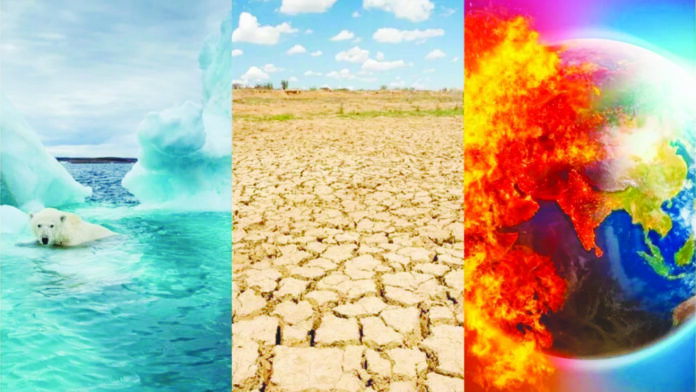The rising temperatures all around the world and the global transition of ‘global warming’ to ‘global boiling’ marks a critical juncture for humanity. The term “global boiling” was coined by António Guterres, the present head of the United Nations, during a news briefing on 27 July 2023. As our planet heats up, increased water vapour— also a potent greenhouse gas— turbocharges extreme weather events, leading to this new era of “global boiling” showing the increasing severity and intensity of climate change impacts, particularly those related to rising temperatures.
Global boiling compresses the urgent and alarming nature of the current climate situation, highlighting the dire need for immediate and comprehensive action. In such a case, Pakistan, like numerous other nations, is highly vulnerable to the impacts of global boiling. Despite being a fractional emitter (less than 1% of global greenhouse gas emissions), Pakistan ranks as the fifth most vulnerable country to climate change, according to the Global Climate Risk Index. The effects of climate change in Pakistan such as, rising temperatures, extreme weather events, water scarcity, food insecurity, glacier melt, flooding, and coastal vulnerability, have economic as well as social implications for the country. Therefore, Pakistan needs to review its policies pertaining to climate change to apply preventive measures for upcoming implications of climate changes and manage the climate crisis at the present stage.
Agriculture is the backbone of Pakistan’s economy, employing nearly 40 percent of the workforce which contributes about 19 percent to the national GDP. However, rising temperatures are severely disrupting this sector. According to the Pakistan Meteorological Department, temperatures in Pakistan have risen by approximately 0.6°C over the past century, and projections suggest a further increase of 1.4-3.7°C by the end of this century. According to the agronomists a 1°C temperature increase can lead to a decline of approximately 194,740 tons in rice production. Similarly, wheat production faces a reduction of about 351,234 tons due to rising temperatures. Maize production is impacted, with an estimated decrease of 387,812 tons. Moreover, rising temperatures affect sugarcane production, resulting in a decline of around 349,128 tons and cotton production is also compromised, with an approximate reduction of 5,519 tons.
All of the mentioned crops are the top export or consumption crops of Pakistan, impact on its yield will directly affect the GDP of the country. If floods are bringing up fertile soil which can be beneficial for quality crops, higher temperatures may lead to increased evapo-transpiration, which reduces soil moisture and impacts crop yields. Staple crops like wheat, rice, and maize are particularly vulnerable. The International Food Policy Research Institute (IFPRI) projects that wheat yields could decline by up to eight percent by 2050 due to climate change. This decline in productivity threatens food security and increases the risk of hunger and malnutrition in Pakistan.
Flooding is another major concern. In 2010 and then again in 2022, Pakistan experienced one of the worst floods in its history, affecting over 20 million people and causing economic losses which include damage to structures exceeding $4 billion, and wheat crop damages were estimated at over $500 million. The total economic impact may have been as much as $43 billion.
Moreover, Pakistan has witnessed an alarming increase in extreme heatwaves. The heatwave that struck Karachi in 2015, claiming over approximately 2000 lives, serves as a grim reminder of the deadly effects of rising temperatures. This year, from June 20 to 26, a total of 568 deaths were reported due to extreme temperatures. On June 25 alone, 141 people lost their lives. According to the reports, the Edhi ambulance service transported approximately 30-40 individuals daily to the Karachi morgue during this period. Such extreme heat events are becoming more frequent and intense, posing significant health risks. Rising temperatures have direct and indirect effects on public health, posing a severe threat, particularly to vulnerable populations such as the elderly, children, and outdoor workers. Additionally, higher temperatures exacerbate air pollution, leading to respiratory and cardiovascular diseases.
Also, Pakistan should actively participate in global efforts to reduce greenhouse gas emissions and advocate for climate justice, ensuring that the most vulnerable populations receive the support they need to adapt to a changing climate. The future of Pakistan hinges on its ability to navigate the challenges posed by rising temperatures.
According to the World Health Organization, air pollution has caused around 60,000 deaths annually in Pakistan. Moreover, vector-borne diseases like malaria and dengue fever are also influenced by rising temperatures. In 2022, Pakistan faced a surge in dengue cases due to historic flooding, resulting in 52,894 cases and 224 deaths. As of September 2023, Pakistan reported 25,932 confirmed dengue cases and 62 deaths, with 74 percent of these cases occurring in September alone. The National Institute of Health (NIH) in Pakistan also confirmed reports of a growing number of dengue fever cases in recent years, correlating with rising temperatures.
Pakistan is already a water-stressed country, and rising temperatures are exacerbating this issue. The Indus River, which provides water for 90 percent of Pakistan’s irrigated land, is highly dependent on glacial melt. As global temperatures rise, the glaciers in the Himalayas, Karakoram, and Hindu Kush Mountain ranges are melting at an accelerated rate. For instance, glaciers in Pakistan’s Gilgit-Baltistan and Khyber Pakhtunkhwa regions are melting rapidly, creating over 3,000 lakes, with around 33 at risk of sudden bursting, endangering seven million people.
Although the initial increase in water flow from melting glaciers might seem beneficial to the average person, the long-term consequences will be faced by future generations. Glaciers, which act as natural water reserves, are melting, leaving no preserved water for the future. While the lakes formed from this melt might appear advantageous, extreme heat will eventually cause them to evaporate, leading to their drying up. Although the government has done a little to prevent floods in those regions, unfortunately, it has done nothing to preserve these lakes or the water from the melted glaciers. This lack of action will ultimately result in reduced river flows, causing severe water shortages throughout the country.
According to the Pakistan Council of Research in Water Resources (PCRWR), Pakistan is expected to face absolute water scarcity by 2025 as fresh water availability has dropped to less than 1000 cubic meters per capita. The country’s water consumption is projected to increase to 274 Million Acre-Feet by 2025, while supply will be down to 191 MAF, leaving a massive gap of 83 MAF2. In 1950, water availability per capita was over 5,000 m3, but it has steadily declined over the years with the increasing heat and high temperatures, and by 2025, it is expected to touch the “absolute water scarcity line“. This dire prediction is further supported by the World Resources Institute (WRI), which ranks Pakistan as the 23rd most water-stressed country in the world.
The boiling temperatures and their impacts on Pakistan underscore the urgent need for comprehensive climate action and change in Pakistan policies towards climate change. Mitigating the effects of rising temperatures requires a multi-faceted approach, including enhancing water management and preservation practices, investing in climate-resilient agriculture, improving disaster preparedness particularly regarding the floods, and strengthening public health systems to avoid the spread of diseases and enhancing public health. Additionally, it is crucial that the global community makes every effort to meet respective domestic targets and pool resources to help countries like Pakistan that are already experiencing the crippling consequences of climate change without delay.
Also, Pakistan should actively participate in global efforts to reduce greenhouse gas emissions and advocate for climate justice, ensuring that the most vulnerable populations receive the support they need to adapt to a changing climate. The future of Pakistan hinges on its ability to navigate the challenges posed by rising temperatures. With proactive and sustained efforts, it is possible to build a more resilient and sustainable future for all Pakistanis and for the generations to come.























